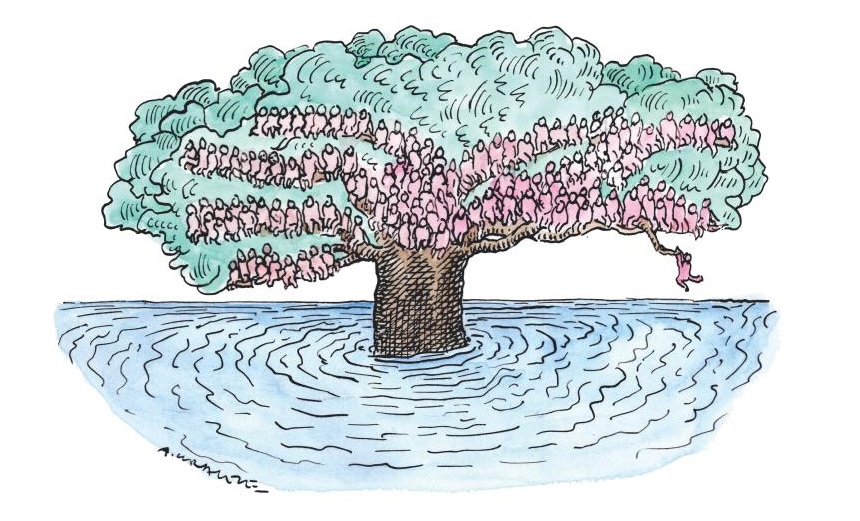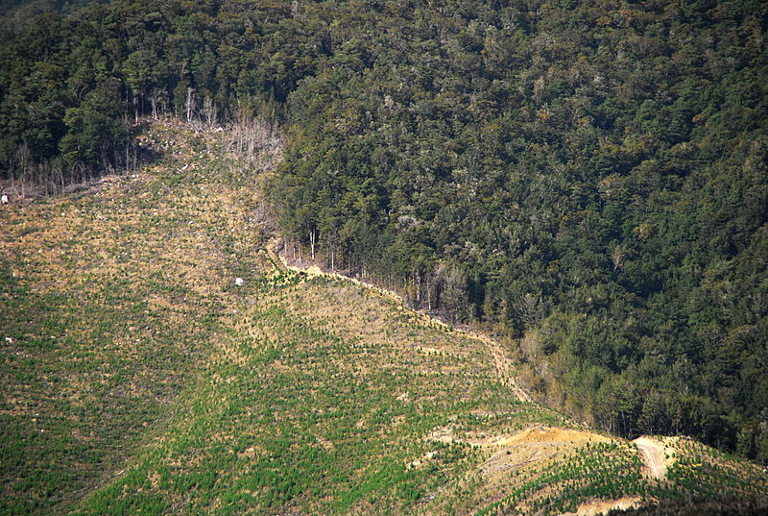This much we know: humanity cannot prevent catastrophic climate change without reducing its greenhouse gas emissions. Tackling the crisis of global warming will therefore demand a radical reshaping of day-to-day life, particularly in the industrialised economies of the global north, where high levels of personal wealth enable equally high-carbon lifestyles. In the past few years, frequent flier culture has come to epitomise these excesses. There is some evidence to suggest that ‘flight shame’ – the guilt brought about by taking a plane in the age of climate change – is causing consumers to reconsider air travel. But many major airlines now give passengers the option of ‘offsetting’ the emissions from their journeys. These schemes, which often pledge to plant or protect a forest, are largely greenwash.
It’s true that trees absorb and store carbon dioxide (CO2), the key contributor to the greenhouse effect, as they grow. But it takes decades for a tree to reach its full CO2-removal potential and deep cuts in emissions are needed immediately to ensure the world meets the Paris Agreement targets. Some schemes claim to save trees earmarked for deforestation, though it’s difficult to prove they would have been felled without funding. Ultimately, offsetting projects are built on a false premise: they tell consumers that it’s possible to save the planet by compensating for CO2 emissions, rather than cutting them. They also perpetuate the false idea that better, more conscious individual consumption – eating organic, driving an electric car – is the solution to the systemic problem of environmental destruction.
Obvious comfort
There is an obvious comfort in believing that life can continue as normal despite the climate emergency. This is likely the reason that studies of the remarkable carbon capturing potential of trees have received an outsized amount of public attention in recent years. One piece of research, published last July in the journal Science, was initially met with particularly widespread media coverage and praise. Its authors estimated that there are 1.6 billion hectares of bare or sparsely vegetated lands worldwide that could support new forest. Of this total, 0.9 billion hectares are not currently being utilised by humans, meaning that there is an area roughly the size of the US available for reforestation. At full maturity, the analysis indicates these trees could sequester over 200 billion tonnes of carbon – roughly two-thirds of all the carbon that has been emitted by humans since the industrial revolution.
An initial statement from the study’s authors, who are based at Crowther Lab at ETH Zurich, called afforestation, or tree planting, ‘the best climate solution available today’. This claim was met with criticism from other members of the scientific community. In a response letter also published in Science, researchers from the University of Bonn and World Agroforestry highlighted, among other things, that soils in many currently deforested areas are too degraded to support new tree life. Around 2.5 billion people also live on the lands the study recommends for reforestation, bringing their true availability into question.
Polls show that millennial and ‘gen Z’ Republicans are more concerned about the climate than older party members. Tree planting promises, like vague calls to cut carbon through ‘innovation’, create a politically expedient illusion of action without having to engage in the messy business of climate policymaking. Neither the Trump administration nor the 1t.org initiative have offered much in the way of detailed plans. But for argument’s sake, imagine that a workforce of tree planters and forestry experts is mobilised in the coming years: where are they going to focus their efforts? And whose land will be appropriated in the name of planetary restoration?
Protect and annex
The United States has a history of annexing and ‘protecting’ wilderness that had long been occupied by indigenous people. Lawmakers set this precedent in 1872, when President Ulysses S Grant signed the Yellowstone Act, thereby creating the country’s first national park. The legislation declared that the 2.2 million-acre tract of land in the country’s vast west was ‘hereby reserved and withdrawn from settlement, occupancy or sale… and dedicated and set apart as a public park or pleasuring-ground for the benefit and enjoyment of the people.’ Of course, this gift was not the federal government’s to give. Indigenous people had lived in Yellowstone National Park for more than 10,000 years, and 26 tribes have ancestral connections to the area. Shortly after the park’s establishment, white superintendents set about making it ‘safe’ for visitors by forcibly removing native inhabitants.
About half of the land selected for protection by the global conservation movements between 1900 and 2010 was occupied or regularly utilised by indigenous populations, according to journalist Mark Dowie, author of Conservation Refugees. The resulting evictions, many of them brutal, have received far less attention than the struggles of communities against extractive industries. For instance, many environmentalists will be aware of ongoing campaigns to prevent the construction of oil pipelines on North American tribal lands. Cases like these fit into a prevailing narrative that suggests the interests of capitalists inherently conflict with the interests of conservationists. But the existence (and persistence) of green colonialism shows that these forces are far from diametric opposites.
In The Conservation Revolution, Bram Büscher and Robert Fletcher argue that early conservation initiatives acted as something of a defence against the harmful social and environmental consequences of capitalist development. ‘In this way, conservation served in part to safeguard capitalism in helping the upper classes that dominated both industrial and conservation realms to cope with the rapid changes and concomitant social, environmental and political upheaval caused by capitalist development,’ they write. In striving to create a ‘pleasuring-ground’, the architects of the Yellowstone Act effectively foresaw the bourgeois desire to retreat to nature for self-restoration. ‘At the same time,’ note Büscher and Fletcher, ‘conservation became a colonial movement, part of broader colonial state-building exercises in the service of empires.’
Modern capitalists know that it’s not practical or sustainable to extract resources from every plot of land available. At the same time, they realise that it is useful to maintain control of the land that isn’t marked for exploitation by positioning themselves as its benevolent stewards. Upon closer inspection, there’s also a tacit admission of failure contained in the late capitalist enthusiasm for forest restoration. In promising to plant one trillion trees, Trump and Davos technocrats have quietly conceded that the economic system that enriched them is also destroying the planet. But try as they might, we cannot plant enough trees to sustain endless fossil-fuelled growth.

Getting afforestation wrong
None of this is to say that forestry projects aren’t an important addition to a suite of carbon reduction solutions. In its special report into land use published last summer, the UN’s Intergovernmental Panel on Climate Change (IPCC) said: ‘Reducing deforestation and forest degradation rates represents one of the most effective and robust options for climate change mitigation, with large mitigation benefits globally.’ Executed correctly, conservation and afforestation initiatives could help reduce levels of atmospheric CO2. However, there are multiple ways to get it wrong.
The IPCC warns that largescale afforestation efforts could end up encroaching on much needed agricultural land – thereby threatening food security by raising food prices. There is also the continued threat of green colonialism, with western governments or NGOs annexing land in the global south and moulding it to fit their picture of a crucial carbon sink. As for conserving important existing forests, there is an increasing body of evidence to suggest that lands under the care of indigenous stewards have better carbon storage and biodiversity profiles than lands managed by governments or private owners. One study of the Amazon, published in January in the Proceedings of the National Academy of Sciences, found that protected indigenous territories have reduced deforestation and forest degradation in the rainforest over the last two decades.
The analysis also suggested that indigenous territories were more effective than other lands in holding their stocks of existing carbon intact. Separate research from 2018 showed that indigenous and community lands are a globally important carbon sink, holding at least 22 per cent of the carbon stored in tropical and subtropical forests and at least 17 per cent of the total carbon stored in forests. According to the World Resources Institute, a non-profit body focused on environmental sustainability, there is ‘considerable potential for more carbon to be stored on degraded indigenous and community lands if they were secured, better protected and restored’.
On its website, 1t.org promises to overcome the socioeconomic barriers to reforestation by ‘catalysing top-down system change – such as policy change, incentives, market creation and access to funding and technology’. This suggests that the free market has the tools (capital, technology, supply and demand dynamics) to solve a problem that the free market created. The ideological divides within green industries have shown that a ‘just’ energy transition is not possible under an extractive paradigm. Huge quantities of lithium and cobalt, for instance, are required to make batteries for electric vehicles – and the human rights abuses associated with mining the minerals are increasingly well documented.
Hidden emissions
Elsewhere, investigations into the financing of renewable energy in Africa have shown that returns on clean infrastructure projects are expatriated by investors from the global north – rather than reinvested locally. For years, neoliberal global development institutions have insisted that emerging economies will ‘leapfrog‘ over fossil fuels and derive their power straight from renewable sources. But actual investment figures don’t reflect this ambition. New clean energy investment dropped by a fifth in developing countries in 2018, the last year for which data has been published, while coal power hit a new high.
There are a multitude of local and international factors hindering the expansion of renewable energy in the global south. And the continued use of coal poses an obvious threat to the long-term health of the entire planet. While the global north, and Europe in particular, is leading in decarbonising its power supply, its demand for cheap goods from emerging economies is driving continued emissions abroad. The UK, for instance, has committed to cutting its carbon output to net zero by 2050 and has made serious progress in integrating renewables into its own energy system. However, a recent report from the World Wide Fund for Nature (WWF) found that about half of the country’s true carbon footprint comes from ‘invisible’ sources, namely emissions released overseas to make products that are consumed here.
These hidden emissions are not covered under the UK’s carbon reporting protocols – and the communities that produce items for export will suffer the immediate health consequences of proximity to dirty energy production. The problem of ‘outsourced’ pollution is yet another symptom of a global economic order at war with itself. Governments in the global north ostensibly want to protect – i.e. manage and control – the fragile ecosystems of the global south for the purpose of sequestering carbon. Yet they also want to import mass volumes of clothes and electronics that contribute to the continued degradation of these environments. And they’re only interested in helping emerging economies decarbonise if they can reap the profits.
These kinds of colonial relations will be perpetuated so long as continued economic growth is prioritised over human lives in the fight to contain global heating. Yes, confronting the climate crisis will require a switch from ‘dirty’ to ‘clean’ power. But it also demands a radical reconfiguration of environmental power dynamics.
‘Shut down a coal plant, and you can slow global warming for a day,’ writes environmental historian Jason W Moore in Capitalism in the Web of Life. ‘Shut down the relations that made the coal plant, and you can stop it for good.
Jennifer Johnson writes about environmental issues. Illustration by Andrzej Krauze.
Teaser photo credit: Deforestation on the Tasman Coast, New Zealand. Photography by Martin Wegman (CC-BY-SA-3.0)





